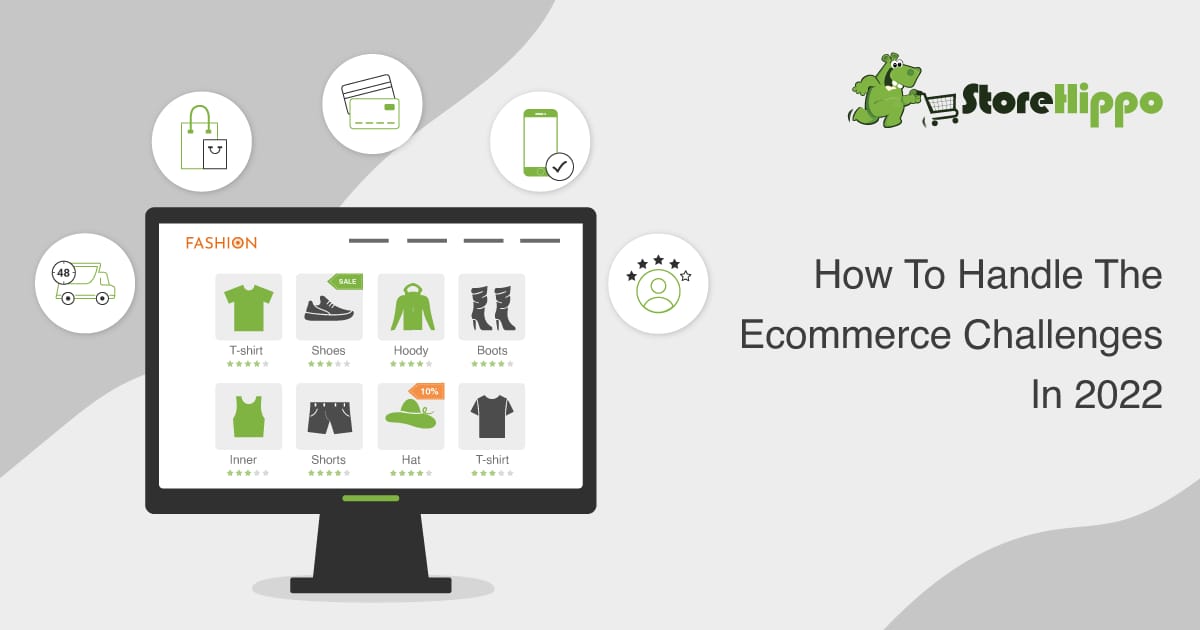The eCommerce industry has drastically grown over the last decade. The sector amassed 2,854.8 billion dollars in global sales, even during challenging years like 2020. However, the numbers pales knowing that the industry is expected to grow over 47% in the next five years .
These numbers seem reasonable when analysed together with the number of users opting for online solutions in routine life. Still, merely knowing the figures will not yield results for your online business. While 2020 helped the eCommerce industry flourish, not every business was able to leverage the opportunities.
So how can your business not fall in the latter category? Is there any way to prepare your brand for 2022? For starters, you can attune your brand to some upcoming trends.
On that note, here is how your online store can survive the challenges of 2022.
Table of Contents
5 Tested tips to handle the ecommerce challenges in 2022

1. Adopt advanced trends and technologies
While standard market practitioners can help your business, they can only maintain relevance by adapting to new trends. Nowadays, businesses are separating their frontend and backend layers to maintain flexibility. The process, known as headless commerce , bodes well with quickly changing market settings.
Moreover, technologies like AI, ML, chatbot, voice-based search, etc., are becoming a norm among online stores. The technologies make it easier for businesses to understand the customers. Moreover, they simplify the shopping experience for consumers, making it a win-win for both parties.
2. Adopt mobile commerce in your strategy
Creating a mobile-friendly store experience is common knowledge in 2021. However, you may not realize its true importance.
Did you know that smartphone users access shopping websites at least once every week ( source )? With 6.37 billion global smartphone users, the niche presents immense sales opportunities.
Thus, your eCommerce store must boast a mobile-friendly interface and design. Establishing the right details can take time, so do not be afraid of trying new aesthetics. A mobile-optimised store caters to a quickly growing demographic, helping you stay relevant among modern customers.
In addition, working on a mobile app can drive new prospects towards your business. Users spent over 5.31 billion dollars on mobile apps in 2021 Q2 alone ( source ). A responsive mobile app with timely notifications reminds the users what they can get in just a click. The fact that there are almost 6 million apps in regulation shows users' turn towards an app-dominated market ( source ).
3. Direct-to-consumer is the new norm
Direct-to-Consumer or D2C is quickly becoming the new norm for the online commerce sector. A study has found that almost 55% of users prefer shopping from manufacturers and not retailers.
The standard retail flow goes like this: Manufacturer - Wholesaler - Distributor - Retailer - Consumer. It takes the products through additional channels, costing consumers more time and resources.
Contrarily, a D2C model takes this approach: Manufacturer - A Digital store / Mobile commerce Channels - Consumer. Thus, it eliminates unnecessary friction to present the products directly to end-users.
The method is beneficial and packs immense potential. By directly facilitating the production and delivery, a D2C model eliminates the need for additional human resources to boost sales.
It eliminates the need for wholesalers, retail stores, brokers, etc, thriving on the already-established business resources. Moreover, it reduces the final cost for consumers while allowing your business to moderate operating, distribution, marketing, and sales cost.
Social media platforms, a mobile app, and an online store are some of the best digital channels for businesses integrating the model. The goal is to avoid middlemen and establish a direct channel with the customers. However, since businesses cannot use it for every product, they must conduct market research to target selective segments. Brands’ with well planned D2C strategy can boost their sales many times over and also get better customer insights to grow their brand.
4. Identify purchase patterns for better customer understanding
Before delving into complex trends like headless commerce, you should try simpler methods like understanding purchase patterns. Identifying user tendency is standard practice, and it will stay relevant even in 2022. Before dishing out new updates or policies, assess how customers have been acting recently.
What products are they preferring? Are they more active on specific days? Are customers leaving the site after comparing to the competitors? How long does it take for buyers to make another purchase?
Nowadays, you can use analytics and tools to easily find out crucial information about the audience. It includes your audience’s most active time and day, what type of products they are buying/shortlisting/viewing, what price range they are checking, and much more.
Names like Google Analytics and Facebook Audience Insights have worked wonders for numerous ventures. Your business can also use the tried-and-tested formula to render consistent results. Along with this brands can also use the inbuilt analytics of enterprise ecommerce platforms to strategize their marketing and customer acquisition plans.
5. Target abandoned shopping carts for instant results
Almost 70% of users add products to carts, only to rarely buy them. It is crazy to think how much your store can earn if it breaks through these abandonments. Most of the time, customers leave the products for common reasons, like:
High shipping cost
Better price on competitor eCommerce website
Wrong timing
Issues placing the order
Complicated buying procedure
Unresponsive platform
Unexpected charges
The best way to minimize abandoned carts is to reach the customers via email or other channels. Find out why they are leaving the products and address the concerns. You can even introduce perks like free shipping and loyalty programs to incentivize users.
6. Multi channel customer engagement
Product descriptions and FAQs only answer users’ general questions. Currently, even the most advanced eCommerce stores have no instant way to resolve customers’ product-related queries. That’s why your business must present multiple interaction channels to the customers.
Besides the standard FAQ section, add prospects like video consultancy, live chat, email and phone support, etc. In addition, you should establish an active social media presence where customers can interact with the brand. Instagram, Twitter, and Discord are some of the top platforms for customer engagement.
The more the customers understand the product and your brand, the more likely they are to engage with it.
Conclusion
Sustaining the market in 2022 can sound challenging, given the quick and extreme shifts the eCommerce is witnessing. However, readying your business for some trends can help you achieve the goal. The ideal approach is to devise a balanced strategy, accounting for standard and modern market trends. The better strategy you formulate, the better revenue you will incur.
Promoting sales and building your eCommerce brand's prestige with cutting edge solutions can be challenging. However, StoreHippo can simplify the process.
StoreHippo comes with 300+ inbuilt features , unparalleled scalability and inherent flexibility that can easily build tailor-made solutions for multiple industries and business models. The fully integrated StoreHippo platform has 120+ built-in integrations and allows brands to easily integrate with any software or service provider of their choice. Built grounds-up on the mobile first principle and headless architecture, StoreHippo can easily create multiple customer touchpoints using the same backend and APIs.StoreHippo comes with an inbuilt abandoned cart follow up module that helps in reclaiming lost carts. StoreHippo also offers a host of tools and easy integrations like livechat, real-time notifications etc. to engage and convert customers better.
What's more is that you can get a 14 days free trial to experience the features in real-time.





















5 Comments
Leave a Reply
Leave a Reply
Leave a Reply
Leave a Reply
Leave a Reply